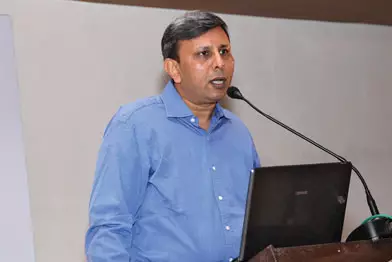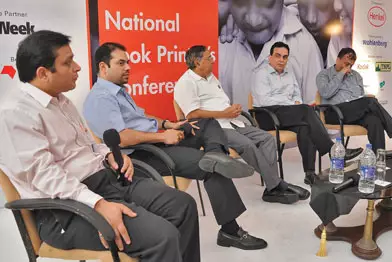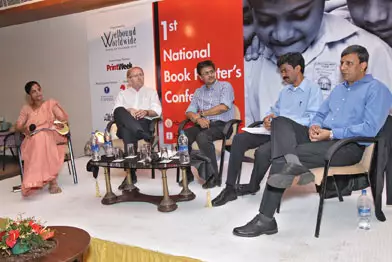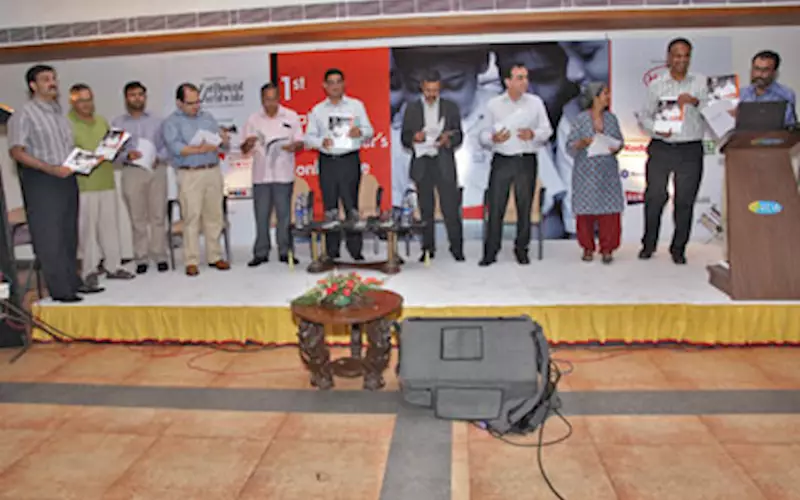Bookonomics of India's exports
Indian book exports was Rs 1,600 cr in 2009-10. Noel D'cunha reports from the NBPC conference about how India needs to do a better job at winning hearts than the international counterparts
07 Dec 2011 | By Samir Lukka
Today, India’s book exports is about 0.5% of the world exports. The main aim of the conference was to create an edifice that will ensure India becomes a foremost book print country by 2017.
For that to happen, many more books will have to be created. In India, the government has made a commitment of $7.56-billion every year for a period of five years and has set aside $3.33-billion for 2010-11. This should improve the quality and availability of schoolbooks.
The good news is, India is poised on the cusp of a great educational revolution. Today, if one averages seven textbooks per literate student, the government prints 1.5- billion books per year for 1-10 standard. Then there are private publishers who add 300-million to this tally.
Higher education is equally – if not more demanding – than ever, due to the proliferation of private universities and colleges. About 100-million books are estimated to be catering to this segment. Approximately two billion books address the educational segment. Of this about 50% is produced by adhesive binding methods.
Book printers follow the fortunes of these publishers and have tried to match their buyer in sizes and segments. The size of domestic book printing is about Rs 7,000-crore according to the survey by Pira International of UK. This is predicted to reach Rs 10,000-crore in 2016.
Our share in the global book print industry {the size of trade market (import and exports) of books and book print services in 2010: US $ 75 billion or Rs 3.75-lakh crore} is about Rs 1,600 crores ,which is less than 0.5%.
According to the Capexil data (2009), India exports to more than 150 countries and the main export destinations are the USA (12%) and UK (11%).
What is alarming is: India ranks poorly in book imports (in terms of trade value) by most countries for 2009:
Central African Republic – India’s rank is 17
Egypt – India’s rank is 19
Indonesia UK – India’s rank is 14
Kazakhstan UK – India’s rank is 46
Malaysia – India’s rank is 12
South Africa – India’s rank is 9
Thailand – India’s rank is 22
Turkey UK – India’s rank is 22
UK – India’s rank is 12
The point is, India’s position in terms of trade value is lower than UAE.
As Pramod Khera, exeutive director of Repro India pointed out in his presentation, the reasons for this are:
(a) fragmented nature of the industry
(b) unbalanced trade laws – benefits for exports are not much, whereas books can be imported free of duties
(c) infrastructural issues
(d) lack of marketing initiatives etc
(e) lack of co-ordination among the key stake-holders.
While China is investing heavily to become the largest book printers to the world, India lags behind. Even Thailand is home to a thriving publishing industry of 1,020 publishers and over 4,700 printers according to the United Nations Industrial Development Organisation statistics.
Print exports in 2009 were worth over $1.5 billion, while in the first quarter of 2010; exports reached $ 554 million and overall could have topped $2 billion.
Export markets for India include Japan, Singapore, Denmark, Hong Kong and Taiwan. UK is India’s largest importer of books and book print services. Even so, we’ve not monetised our position, despite having a language advantage. Our trade advantage is visible in Bhutan, Nepal and Sri Lanka (we rank number one), Nigeria and Kenya (we rank number two), Oman (we rank number three after UK and UAE).
There’s a saying: "Indians glory in the past, worry about the present, and are uncertain about the future." It certainly sums up our assessment of the national book industry.
The NBPC kicked off with a keynote address by Professor Werner Rebsamen and culminated with the release of a White Paper. Professor Rebsamen shared 60 years of experiences in book manufacture and especially in book binding. He talked about the journey of the book printing and binding, stating that "Book binding was restricted to only rich people. In fact, only the rich could afford book. None of the books then were trimmed. You had to carry a knife to trim each page."
He spoke about the skills in book binding, manual to automated. He informed the audience about world’s first fully automated book manufacturing systems he set-up. "It was revolutionary but caused many problems engineers could not even think about: Bulk variations, dry book blacks and warped book covers," he said.
The keynote address was followed by two panel discussions. The first, discussed technology trends in the Indian book market – and was chaired by Faheem Agboatwala. The general consensus was that India and China will drive the printing needs of the world. "There are certain products which are designed to be produced perfectly in India. India has a great chance to become a leading nation for our industry," said Michael Euler of Wohlenberg.
PUR came in for discussion. "It’s been there in Germany from a long time. At Drupa, people will see new types of PURs and I am not talking about spine creation technology," said Euler.
Wastage is a burning issue. "I have seen that Indian companies operate on vast and varied levels, thus creating lot of wastage at each stage," said Herbert Herrmann.
More people, more hands, more issues. Anil Krishna of Henkel said, "I have looked at every industry and I feel, we need to educate ourselves. 40% of our country is BPL, we need to educate them to get the industry rolling."
The second panel discussion had India’s super printers discuss their success story; opportunities and pain points. Gautham Pai of Manipal Technologies, Jayaraman of Multivista Global, Pramod Khera of Repro India and Kapil Raina of Thomson Press. The panel was chaired by Ramu Ramanathan, editor of PrintWeek India. Sadashiv Nayak, CEO of Big Bazaar was the respondent.
India is the market most people are looking at. As far as exports are concerned, India is just one of the many. The impact of crisis in Europe and America has hampered exports. "Publishers have, therefore, either tied-up or opened new offices in India," said Raina. He added: "We were one of the first printers who started to print on 28 gsm bible paper."
Giving an account of Multivista’s success, Jayaraman said that his company has moved to a five-acre facility, and added machinery and storage capacity. "It has given us an advantage not only in the domestic but international markets."
Manipal Technologies, in terms of quality, is second of none. "But cost is an issue," said Gautham Pai of Manipal Technologies. "Compared to China, India is seen as a risky partner. Reasons: lack of infrastructure, logistics, etc." Pai was of the opinion that if one has to add capacity, "it’s better done organically, so that one can build the right culture from day one."
Pramod Khera of Repro India was very bullish. "Having spent three years in the industry, I feel the industry has very strong roots. We have technical knowhow, if we get our act together, we have huge opportunities ahead."
The highlight on day two was a comprehensive presentation by Thomas Abraham. The managing director of Hatchette India analysed trends in Indian publishing. Abraham kicked-off his presentation by examining how India brands itself overseas; and if books fit into this metrics. "We are a growth story, it’s there in the TV channels. But where are the book stores?" he asked. Thomas said that he sought views from production heads from his company around this region on the China versus India topic and why China is ahead of us. "It wasn’t surprising," said Thomas.
He presented the views: "India is more preoccupied with domestic market. Whereas China has focused attention on export market since beginning as they were not licensed for domestic production"; "The four-colour printing in India is 15% more expensive. This may be because paper is 30% more expensive. We have been concentrating on mono-colour printing while China has focused on four-colour printing where the quality requirements are high"; "China holds running stocks of paper for series of fast moving titles. This saves around weeks time." Thomas was of the opinion: "Straight monochrome is around 70%. Monochrome is a huge opportunity if you can manage well." He cautioned the gathering: "Examine seriously if there’s any point on catching up with China."
The first panel discussion on day two saw leading Indian publishers like Cinnamon Teal, Hatchette India and Pearson Group chaired by Jaya Bhattacharji Rose - author and independent publishing consultant discuss expectations from the Indian book printers.
The publishers argued for greater transparency and the need for printers to say ‘no’. "When we ask for time, we need to calculate the time required. All of us have workflow either on paper or in our heads. We have ERP systems, but we hardly invest into workflow systems. We need digital workflows to project and guide the progress of the work," said Subhasis Ganguli of Pearson Group.
Copyright and price were some of the other issues which were discussed.
This was follwoed by the key-note address of day two by Pramod Khera, executive director of Repro India. He announced the concept of a Book City in India. He said: "We’ve conceptualised a "Content and Book City" plan, which is an eco-system for setting up the content management and print services." Under this concept, the top book print firms (with a partner in the infrastructure space) will build the infrastructure and invite content, print and related media companies / entrepreneurs to offer services and products – being tenants both in a central SEZ and a domestic tariff zone. The core group of top book print firms, through its relationships with global publishers, will bring in business from around the globe and the partner units will be executing the same, in addition to the business that they source on their own.
Khera said: "The endeavour is to transform the printing industry in the country from an unorganised, fragmented "industry" to a well-directed, income and profit generating industry with a well-charted future capable of handling global requirements."
The second panel discussion of the day, which preceded the launch of the White Paper had Bhuvnesh Seth of Replika Press and Vasant Goel of Gopsons Papers join Pramod Khera. The discussion emphasised the need for better margins and more volumes.
Their vision was endorsed by a majority of the delegates who felt the time is apt "to work towards creating a culture for the book industry in India."
Future Action Plan
1 Set up an organisation structure which will implement the action plan.
2 Collective forum of Indian book printers plus publishers for national and international forums.
3 Development council group which will interact with government and semi- government bodies; and be instrumental in policy decision.
4 Cost calculator similar to Crisil rating so that parameters such as operating cost, productivity, turnaround, run lengths and substrate compatibility can be made available.
5 Setting up a research body that can survey the perceived break-even volumes for books produced in India versus demand estimation of books in trade/education (10+2 and graduation/professional/regional language education).
6 Training courses, workshops and technical demonstrations for soft issues like wastage (pilferage, damage, obsolescence), returns, cost of capital, real estate cost of storage, cost of lost opportunity due to resources being occupied in other activities. Understanding how these soft costs are measured, quantified and valued by the manufacturers.
7 Create a discount global store which can buy and sell books in real time. To create a process flow for ordering and re-ordering of books, which excludes bottlenecks and other pain points.
8 Promotion of India as a book print destination - Government to sponsor India based-themes in Frankfurt Book Fair, London Book Fair and many others
9 Regular match-making sessions between Indian printers and publishers to highlight their collective capacity, so that Indians are no longer projected as a fragmented lot.
10 Promotion of Book City among the various stake-holders and state government.
The key speakers

Khera of Repro: unveiling the Book City blue-print

Abraham of Hachette - pros & cons of Indian publishing
Glimpses from the session

Panel discussion 1: the manufacturers

Panel discussion 2: the super-printers

Panel discussion 3: book publishers and specialists











 See All
See All